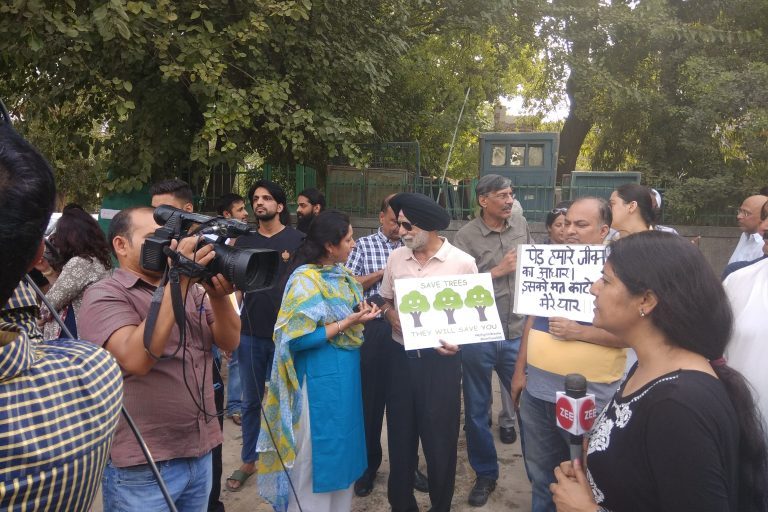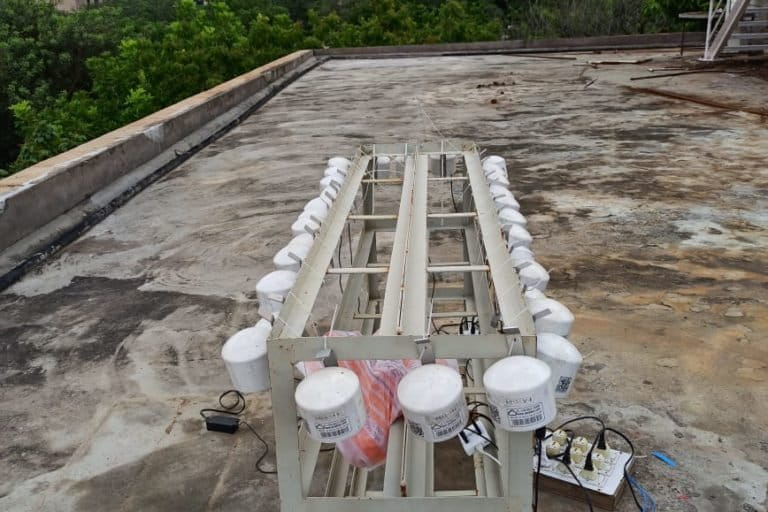- Exposure to tiny particles found in dust and smoke (particulate matter 10 or PM10), regardless of hygienic practices, increases the risk of adverse child health outcomes, said a survey of 184 Indian cities and towns.
- Impacts of PM10 on child health outcomes did not vary between cities that come under the National Clean Air Programme and those that are not under its ambit, the survey said.
- Experts call for addressing the data gap for air pollution levels in rural India by applying a mix of technologies such as satellite data and low-cost sensors, integrated with the reference-grade monitors.
Exposure to fine particles (PM10) found in the air increases the risk of harm to child health irrespective of hygiene practices, said a survey of 184 Indian towns and cities. The survey also calls for addressing the air pollution data gap in rural areas.
Published in the BMJ Global Health journal, the study notes that the effect of PM10 on child health outcomes did not vary between cities that come under the National Clean Air Programme and those that are not under its ambit (NCAP and non-NCAP cities).
“Air pollution has its impacts on child health irrespective of hygiene practices. Regardless of hygienic practices, breathing in filthy air (with high PM10 levels) increases the risk of adverse child health outcomes. These are premature birth, acute respiratory infection (ARI), low birth weight, and more,” said study author Bidhubhusan Mahapatra of the Population Council at New Delhi.
“So, improved sanitation combined with clean air can prevent loss of several newborn lives. Both aspects are important for better health of children,” Mahapatra told Mongabay-India.
Overall, with every ten µg/m3 (microgram per cubic meter) increase in the PM10 level, the risk of neonatal mortality shot up by six percent, the odds of experiencing ARI symptoms by seven percent, and premature births by eight percent. “We find that exposure to PM10 not only impacts children but also pregnant women, resulting in premature births,” said statistician and study co-author Monika Walia, formerly with the Population Council.
PM10 are particles ranging between 2.5 and 10 micrometers and common sources include vehicular exhausts, smoke from fires, dusty industrial areas among others. Particulate matter 2.5 (PM2.5) are particles of a smaller size. “PM2.5 particles are lighter than PM10 and go deeper into our body, causing more harm than coarse particles. So if PM10 can cause such adverse effects on child health as shown in our study, then PM2.5 will lead to more severe impacts,” cautioned Walia, currently Data Manager, Poverty, Health, and Nutrition (PHN) Division at International Food Policy Research Institute (IFPRI), New Delhi.
The study builds on a growing body of research that hammers in the linkages between air pollution and health in India, particularly for vulnerable communities. For example, in a 2019 study, IIT-Delhi’s Sagnik Dey and colleagues warned that improved sanitation access for children in rural areas might arrest stunting. Still, early-life exposure to high levels of air pollution could play spoilsport in realising these benefits. Their study found that foetus and newborns’ exposure to outdoor air pollutants (especially PM2.5) is significantly associated with child height deficits.
India is today the world’s second most polluted country. Stubborn air pollution robs the average Indian of more than five years of their life expectancy, according to the Air Quality Life Index 2020 Annual Report published by the Energy Policy Institute of University of Chicago (EPIC).
The researchers measured the effect of PM10 exposure on various child health outcomes by linking two sources of data: National Family Health Survey-4 (NFHS-4) and air quality data provided by the Central Pollution Control Board. NFHS-4 observations for rural areas were removed from the study as PM10 data is only available for urban areas. “We considered carrying out the analysis using PM10 because it has greater coverage i.e. PM10 data were available for longer durations and for lot more cities than PM2.5,” said Walia.
The 184 districts/towns covered 24 states and three union territories of India. The survey covered districts in states such as Andhra Pradesh, Chhattisgarh, Assam, Himachal Pradesh, Kerala, Karnataka and others. Of these 184 towns, as many as 95 are priority districts under the NCAP.
The NCAP launched in 2019 is a long-term, time-bound, national-level strategy to tackle the air pollution problem across India in a comprehensive manner. It targets 20-30 percent reduction in PM10 and PM2.5 concentrations by 2024, keeping 2017 as the base year for the comparison of concentration. It includes 122 non-attainment cities- cities that violate the National Ambient Air Quality Standards (NAAQS). The plan proposes the implementation of city-specific air quality management plans for non-attainment cities.

The authors emphasise stepping up efforts to measure air pollution in rural areas, at least in the rural areas located on the peripheries of urban areas, because the lack of data on air pollution levels in rural areas remains a critical gap in India’s efforts to address air pollution. Studies have shown that while sources may be somewhat different, polluted air “kills as easily in the rural areas as in the cities” in northern India. “The effects of air pollution were not limited to metro cities in our study; rather, it was pan-India. So the focus should be expanded to reduce air pollution in fast-developing second and third-tier towns,” said Walia.
Disease burden and air pollution levels
Three factors shape the air pollution burden or the cumulative impact of air quality on life. “The level of exposure, the population exposed to a particular level, and the background disease rates, which is a reflection of the overall healthcare systems. It means that even if the air pollution level remains unchanged, the burden will increase because the population will keep growing. Also, if the population age structure shifts to an older age, the risks increase,” said Dey.
Unless the air pollution level goes down substantially, the impact will not reduce. And this is not possible if only the urban centres are targetted. This is the first challenge.
The second challenge is poor healthcare in rural areas. “In the India Global Burden of Disease Study (GBD) exercise, it is realised that the air pollution burden is much higher in the states of Uttar Pradesh and Bihar than in Delhi, although the pollution level is higher in Delhi. This is because the background disease rate is much lower in Delhi, and Delhi has a smaller population,” explained Dey.
In rural areas, household air pollution exposure is also higher than in urban areas. Therefore, the overall exposure (a combination of outdoor and indoor) remains high. But, this presents an opportunity to deploy clean fuels and electrification to do away with kerosene and firewood use which will clean up the household air in the rural area. The outdoor air will also be cleaned as household sources contribute 50-70 percent to outdoor air pollution.
Dey, who was not associated with the PM10 study, agrees with the researchers that urban boundaries do not limit air pollution impacts. “NCAP, though focused on the urban centres, is a good start because it acknowledged air pollution as a national problem. However, as the NCAP is evolving, it should connect to the other programs such as Pradhan Mantri Ujjwala Yojana and rural electrification scheme for an integrated regional plan,” Dey said.
Addressing the data gap in rural India
An analysis of action plans of 102 NCAP cities points out the absence of cost estimates for the execution of the action points listed in the plans as the “most glaring shortcoming.” State budgets need to account for the expenses that implementing clean air plans will incur, especially since some actions call for core infrastructural development and the purchase of expensive assets like mechanical street sweepers and real-time monitoring stations, the analysis said.
Officials of pollution control boards of Uttar Pradesh and Bihar, for example, also discussed the funding challenges of the action plans, including cost-effective monitoring technologies, at the India Clean Air Summit 2020 held online by the Center for Study of Science, Technology and Policy (CSTEP).
One way to circumvent the investment challenge is to evolve a hybrid monitoring system with satellite and low-cost sensors integrated with the reference-grade monitors to expand air pollution monitoring to rural areas.
“In the NCAP, the Central Pollution Control Board network will be expanded to cover some rural areas. However, realistically, the investment would be huge and unsustainable for India to maintain an adequately dense network of reference-grade monitors across the country,” he said. However, each component in hybrid systems has its strength and weakness.

“What we need is a system that harnesses the strengths of all these three. We should have reference-grade monitors at strategic locations within each air shed covering both urban and rural areas. Satellite data should be calibrated to provide the regional coverage and help to track the changes in pollution levels,” said Dey. Efforts are on to identify major airsheds in India. Airshed refers to a geographical region that tends to share the same flow of air. The airshed approach was also brought up by researchers for managing future air quality in the Kolkata Metropolitan Area.
“For any mitigation efforts, both local and regional sources need to be tackled. However, with few reference-grade monitors, we cannot interpret which strategy (local vs regional) is more successful. Low-cost sensor (calibrated against the reference-grade) network should be built around the reference-grade monitors to capture the local factors.”
“We (joint efforts with CEEW, colleagues in the USA from NASA, RTI, and UC Berkeley) are planning to deploy an array of low-cost sensors across the Indo-Gangetic plain (Punjab to West Bengal) in the coming months to explore the feasibility of an integrated system. Most of these low-cost sensors will be hosted by citizens, thereby enhancing their engagement and creating awareness. All the data will be available online,” he added.
CITATION:
Mahapatra, B., Walia, M., Avis, W. R., & Saggurti, N. (2020). Effect of exposure to PM10 on child health: evidence based on a large-scale survey from 184 cities in India. BMJ Global Health, 5(8), e002597.
Banner image: A representational image of children playing on the banks of a polluted stream in India. Photo by Neil Palmer (IWMI)/Flickr.
